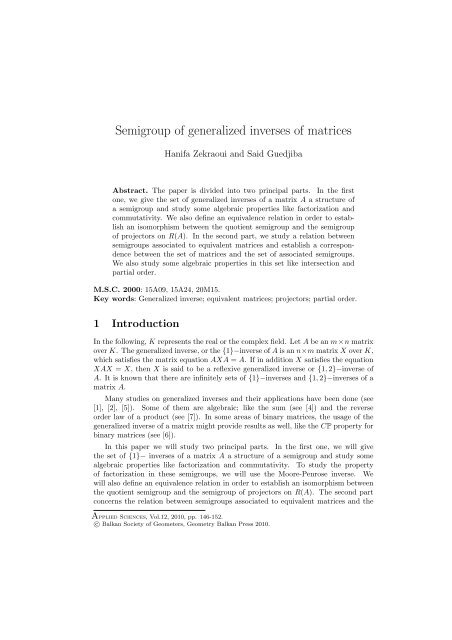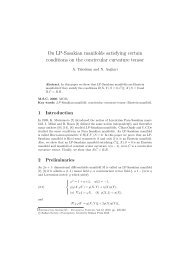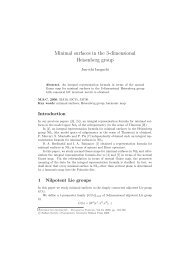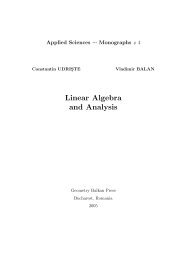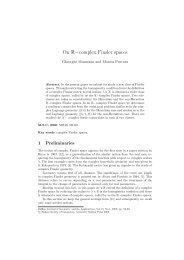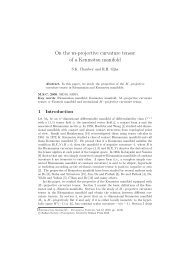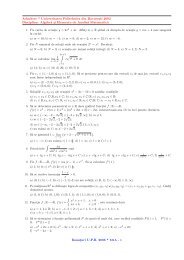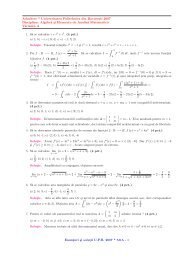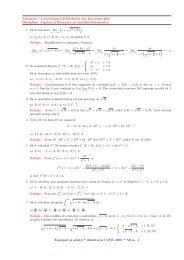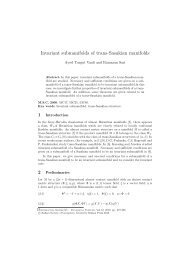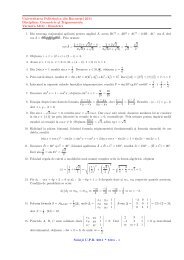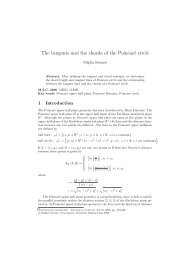Semigroup of generalized inverses of matrices
Semigroup of generalized inverses of matrices
Semigroup of generalized inverses of matrices
Create successful ePaper yourself
Turn your PDF publications into a flip-book with our unique Google optimized e-Paper software.
<strong>Semigroup</strong> <strong>of</strong> <strong>generalized</strong> <strong>inverses</strong> <strong>of</strong> <strong>matrices</strong>Hanifa Zekraoui and Said GuedjibaAbstract. The paper is divided into two principal parts. In the firstone, we give the set <strong>of</strong> <strong>generalized</strong> <strong>inverses</strong> <strong>of</strong> a matrix A a structure <strong>of</strong>a semigroup and study some algebraic properties like factorization andcommutativity. We also define an equivalence relation in order to establishan isomorphism between the quotient semigroup and the semigroup<strong>of</strong> projectors on R(A). In the second part, we study a relation betweensemigroups associated to equivalent <strong>matrices</strong> and establish a correspondencebetween the set <strong>of</strong> <strong>matrices</strong> and the set <strong>of</strong> associated semigroups.We also study some algebraic properties in this set like intersection andpartial order.M.S.C. 2000: 15A09, 15A24, 20M15.Key words: Generalized inverse; equivalent <strong>matrices</strong>; projectors; partial order.1 IntroductionIn the following, K represents the real or the complex field. Let A be an m×n matrixover K. The <strong>generalized</strong> inverse, or the {1}−inverse <strong>of</strong> A is an n×m matrix X over K,which satisfies the matrix equation AXA = A. If in addition X satisfies the equationXAX = X, then X is said to be a reflexive <strong>generalized</strong> inverse or {1, 2}−inverse <strong>of</strong>A. It is known that there are infinitely sets <strong>of</strong> {1}−<strong>inverses</strong> and {1, 2}−<strong>inverses</strong> <strong>of</strong> amatrix A.Many studies on <strong>generalized</strong> <strong>inverses</strong> and their applications have been done (see[1], [2], [5]). Some <strong>of</strong> them are algebraic; like the sum (see [4]) and the reverseorder law <strong>of</strong> a product (see [7]). In some areas <strong>of</strong> binary <strong>matrices</strong>, the usage <strong>of</strong> the<strong>generalized</strong> inverse <strong>of</strong> a matrix might provide results as well, like the CP property forbinary <strong>matrices</strong> (see [6]).In this paper we will study two principal parts. In the first one, we will givethe set <strong>of</strong> {1}− <strong>inverses</strong> <strong>of</strong> a matrix A a structure <strong>of</strong> a semigroup and study somealgebraic properties like factorization and commutativity. To study the property<strong>of</strong> factorization in these semigroups, we will use the Moore-Penrose inverse. Wewill also define an equivalence relation in order to establish an isomorphism betweenthe quotient semigroup and the semigroup <strong>of</strong> projectors on R(A). The second partconcerns the relation between semigroups associated to equivalent <strong>matrices</strong> and theApplied Sciences, Vol.12, 2010, pp. 146-152.c○ Balkan Society <strong>of</strong> Geometers, Geometry Balkan Press 2010.
<strong>Semigroup</strong> <strong>of</strong> <strong>generalized</strong> <strong>inverses</strong> <strong>of</strong> <strong>matrices</strong> 147correspondence between the set M m×n (K) and the set <strong>of</strong> the associated semigroups.Some algebraic properties in this set will be treated; like the intersection <strong>of</strong> semigroupsand isomorphisms. Also, ordering <strong>of</strong> sets in the real inner product space, isa recent subject. In [3], this subject addressed as main result, and proved using theLorentz-Minkowski distance for ordering certain sets. We shall also follow this patternby using <strong>generalized</strong> <strong>inverses</strong> for ordering sets <strong>of</strong> the introduced semigroups by minuspartial order.2 Preliminary notesDefinition 2.1. Let A be an m × n matrix over K. The Moore-Penrose inverse <strong>of</strong> Adenoted by A + is the n × m matrix X over K which satisfies the four equations(2.1) AXA = A, XAX = X, (AX) ∗ = AX, (XA) ∗ = XA.For every matrix there exists only one Moore-Penrose inverse. If X is at least a{1}− inverse <strong>of</strong> A, then AX and XA are projectors on R(A) and R(X) the rangespaces <strong>of</strong> A and X respectively and rank(AX) = rankA = rank(XA). For moreproperties and remarks, see ([1]), ([5]).Denote by A {1} and by A {1,2} the sets <strong>of</strong> all {1}− <strong>inverses</strong> and {1, 2}− <strong>inverses</strong> <strong>of</strong>A respectively. We will denote by small letters the sub-<strong>matrices</strong> <strong>of</strong> a matrix X and byI and 0 the identical and zero <strong>matrices</strong> or identical and zero sub-<strong>matrices</strong>. Lemmaswithout pro<strong>of</strong>s are either easy to pro<strong>of</strong> or well known in the precedent references.Lemma 2.1. Let A be an m × n matrix over K <strong>of</strong> rank r. Then (1) There exist non singular <strong>matrices</strong> P and Q such that A = Q −1 ar 0( )0 0a2) A + = P −1 −1r 0Q.0 0(a3) The elements <strong>of</strong> A {1} are <strong>of</strong> the form P −1 −1rf(aA {1,2} are <strong>of</strong> the form P −1 −1rfefa r e)Q.eg)P .)Q and the elements <strong>of</strong>The first assertion is an elementary lemma in linear algebra. The second one andthe third need only a direct verification in (2.1). For this purpose the pro<strong>of</strong> wasomitted.
148 Hanifa Zekraoui and Said Guedjiba3 Main results3.1 <strong>Semigroup</strong> on A {1}3.1.1 Factorization and commutativityThe main important point in the theorem below is factorization <strong>of</strong> A {1,2} . For thispurpose we introduce two classes <strong>of</strong> A {1} :{( ) }aP A+ A = X ∈ A {1} /X = P −1 −1r xQP AA + =0 0{(aX ∈ A {1} /X = P −1 −1r 0x 0) }Q .The notations P A + A and P AA + are justified by the fact that these two classes are thesets <strong>of</strong> fixed points under left and right multiplications by orthogonal projectors A + Aand AA + . In fact, for any ( X ∈ A {1} ),( )aA + AX = X ⇒ X = P −1 −1r xaQ and XAA0 0+ = X ⇒ X = P −1 −1r 0Q.x 0Theorem 3.1. Let ∗ be a law on A {1} defined as follows: for any X, Y ∈ A {1} ;X ∗ Y = XAY . Then1) A {1} is a semigroup.2) For any X, Y ∈ A {1} we have X ∗ Y ∈ A {1,2}3) A {1,2} is an ideal <strong>of</strong> A {1} .4) P AA + ∗ P A + A = A {1,2} and P AA + ∩ P A + A = {A + }.5) For any X and Y in A {1} we haveX ∗ Y = Y ∗ X ⇔ AX = AY and XA = Y A.Pro<strong>of</strong>. 1) A (XAY ) A = (AXA) Y A = AY A = A. Then X ∗ Y = XAY ∈ A {1} .The associativity <strong>of</strong> ∗ is obtained from the associativity <strong>of</strong> a product <strong>of</strong> <strong>matrices</strong>.So A {1} is a semigroup. 2) Let X and Y be in A {1} . Since A (XAY ) A = A and(XAY ) A (XAY ) = X (AY A) (XAY ) = X (AXA) Y = XAY , we obtain X ∗ Y =XAY ∈ A {1,2} . 3) As A {1,2} ⊂ A {1} , then 3 is just a simple consequence <strong>of</strong> 2.4) First, remark that P AA + and P A + A are subsemigroups <strong>of</strong> A {1,2} . Let A =( )( )Q −1 ar 0aP . For any Z = P0 0−1 −1r xQ ∈ Ay ya r x{1,2} there exist Y =( )( )aP −1 −1r 0aQ ∈ Py 0AA + and X = P −1 −1r xQ ∈ P0 0A + A such that Y ∗X =( ) ( ) ( )( )aP −1 −1r 0 ar 0 a−1r xaQy 0 0 0 0 0−1 = P −1 −1r xQ = Z. Consequently,we have P AA + ∗ P A + A = A {1,2} . ( However, by direct ) computation, wey ya r xafined that P A + A ∗ P AA + = {A + −1r x}. For Z = pQy ya r x−1 ∈ P AA + ∩ P A + Awe have x = 0 and y = 0.Then Z = P( a−1r 00 0)Q −1 = A + . ThereforeP AA + ∩P A + A = {A + }. This assertion can be replaced by uniqueness <strong>of</strong> factorization <strong>of</strong>elements <strong>of</strong> A {1,2} . 5) For any X and Y in A {1} we have XAY = Y AX ⇒ AXAY =
<strong>Semigroup</strong> <strong>of</strong> <strong>generalized</strong> <strong>inverses</strong> <strong>of</strong> <strong>matrices</strong> 149AY AX ⇒ AY = AX and XAY = Y AX ⇒ XAY A = Y AXA ⇒ XA = Y A. Conversely,AY = AX ⇒ XAY = XAX and Y A = XA ⇒ Y AX = XAX. Hence wehave X ∗ Y = Y ∗ X ⇔ AX = AY and XA = Y A.□Note that we have not really commutativity on A {1} , but we have a kind <strong>of</strong>commutativity modulo projectors.It is easy to prove that the set <strong>of</strong> projectors <strong>of</strong> a vector space on a subspace isa semigroup under ordinary composition. As many studies on projectors and theirproperties have been done, we will exploit this to make properties <strong>of</strong> A {1} more easy.This claim will be reached by defining an equivalence relation in A {1} , thus we willhave an isomorphism between the quotient semigroup <strong>of</strong> A {1} and the semigroup <strong>of</strong>projectors on R(A). It will cause no confusion if we use the same letter to designatea projector and its associated matrix.Theorem 3.2. Let A ∈ M m×n (K), Π be the semigroup <strong>of</strong> projectors <strong>of</strong> K m onR (A). Then we have1) For any P ∈ Π, there exists X ∈ A {1} such that AX = P .2) There is an equivalence relation ∼ on A {1} such that under the quotient law <strong>of</strong> ∗,is a semigroup isomorphic to Π.A {1}∼Pro<strong>of</strong>. 1) Let P ∈ Π and A − ∈ A {1} . As AA − is a projector on R (A), we haveAA − P = P and P A = A. Thus if we take X = A − P , we have AXA = AA − P A =AA − A = A and AX = P which means that Π = { AX/X ∈ A {1}} .2) Let ∼ be a relation in A {1} defined by X ∼ Y ⇔ AX = AY . Then it iseasy to check that ∼ is an equivalence relation in A {1} . Let χ be the canonicalmap from A {1} on A{1}A{1}∼. Then for every χ(X), χ(Y ) ∈∼, the quotient law <strong>of</strong>∗ is defined by χ(X)χ (Y ) = χ (X ∗ Y ). It easy to show that A{1}∼is a semigroupand χ is an homomorphism. It immediately follows that there exists a map ψ fromA {1}∼to Π defined by ψ(χ(X)) = AX. Now we check that ψ is an homomorphism.Since A (XAY ) = (AXA) Y = AY , we obtain XAY ∼ Y . Then χ (XAY ) = χ(Y ).Thereforeψ (χ(X)χ(Y )) = ψ (χ (X ∗ Y )) = ψ (χ (XAY )) = ψ (χ(Y )) = AY = (AXA) Y == (AX) (AY ) = ψ (χ (X)) ψ (χ(Y )) .Now, since AX = AY , it follows that χ(X) = χ(Y ). We conclude that for any AX∈ Πthere is a unique χ(X) ∈ A{1}∼such that ψ(χ(X)) = AX which means that ψ is abijection.□3.2 The set A {1} <strong>of</strong> semigroupsDenote by M {1}m×n(K) the set M {1}m×n(K) = { A {1} /A ∈ M m×n (K) } .In this subsection, we will establish a relation between M m×n (K) and M m×n(K){1}and deduce some properties <strong>of</strong> M m×n(K) {1} like isomorphism <strong>of</strong> semigroups, intersection<strong>of</strong> them and relation order. For this main, the following Lemma will be useful.Lemma 3.1. [1], [5]. Let A and B be two equivalent <strong>matrices</strong>, such that B = Q −1 AP .Then, for every Y in B {1} there exists a unique X in A {1} such that Y = P −1 XQ.
150 Hanifa Zekraoui and Said Guedjiba3.2.1 Isomorphism between semigroupsTheorem 3.3. Let A and B be two equivalent <strong>matrices</strong>. Then ( A {1} , ∗ ) and ( B {1} , ∗ )are isomorphic.Pro<strong>of</strong>. By using the previous Lemma, we can define a map ϕ from A {1} on B {1} asfollows ϕ(X) = P −1 XQ. Then ϕ −1 is the inverse map from B {1} on A {1} given byϕ −1 (X) = P XQ −1 . In addition, for every X and Y in A {1} , we haveϕ(X ∗ Y ) = ϕ(XAY ) = P −1 (XAY )Q = (P −1 XQ)(Q −1 AP )(P −1 Y Q) == ϕ(X)Bϕ(Y ) = ϕ(X) ∗ ϕ(Y ).Also, we have for every X and Y in B {1} ,ϕ −1 (X ∗ Y ) = ϕ −1 (XBY ) = ϕ −1 (X)Aϕ −1 (Y ) = ϕ −1 (X) ∗ ϕ −1 (Y ) .Then the map ϕ is an isomorphism.□We remark that ϕ (A + ) = P −1 A + Q = B + only if P and Q are orthogonal.Lemma 3.2. [4] Let A and B be two <strong>matrices</strong>. Then the following statements areequivalent:a) rank(A) + rank(B − A) = rank(B).b) Every {1} − inverse <strong>of</strong> B is a {1} − inverse <strong>of</strong> both A and B − A.c) R (A) ∩ R (B) = {0} and R (A t ) ∩ R (B t ) = {0}.Theorem 3.4. There is a one-to-one correspondence between M m×n (K) and M {1}m×n(K)maps 0 to M n×m (K) and preserves isomorphisms between semigroups.Pro<strong>of</strong>. Let ψ be a map from M m×n (K) onto M m×n(K) {1} defined for every A ∈ M m×n (K)by ψ(A) = A {1} . Since 0X0 = 0 for any X ∈ M n×m (K), we get 0 {1} = M n×m (K). Thus ψ(0) = M n×m (K). According to Lemma 3.2, if A {1} = B {1} , we haverank(A) + rank(B − A) = rank(B) and rank(B) + rank(A − B) = rank(A). Thuswe have rank (A − B) = 0 = rank (B − A). Therefore A = B. Now, let A and B ∈M m×n (K) such that B = Q −1 AP . According to Lemma 3.1 and Theorem 3.3 , wehave B {1} = { P −1 XQ/X ∈ A {1}} = ϕ ( A {1}) . Hence we have ψ(B) = ϕ(ψ(A)). □3.2.2 Intersection <strong>of</strong> semigroupsTheorem 3.5. a) For every matrix A ∈ M m×n (K) there exists a matrixA ′ ∈ M m×n (K) such that A {1} ∩ A ′{1} ≠ ❢ .b) For any <strong>matrices</strong> A, B ∈ M m×n (K) there exists an isomorphism ϕ from A {1} onϕ ( A {1}) such that ϕ ( A {1}) ∩ B {1} ≠ ❢ .Pro<strong>of</strong>. a) Let rankA = r ≤ min (m, n). It is sufficient to prove that for A ∈ M m×n (K)with rank(A) = r, there exists a matrix A ′ ∈ M m×n (K) such that rank (A + A ′ ) =rank(A) + rank(A ′ ) = min (m, n). Applying Lemma 3.2, we have every {1}− inverse<strong>of</strong> (A + A ′ ) is a {1}− inverse <strong>of</strong> both A and A ′ . Thus A {1} ∩ A ′{1} ≠ ❢ . Let P and
<strong>Semigroup</strong> <strong>of</strong> <strong>generalized</strong> <strong>inverses</strong> <strong>of</strong> <strong>matrices</strong> 151( )Q be two nonsingular <strong>matrices</strong> such that A = Q −1 Ir 0P . Then it is sufficient( )0 00 0to take A ′ = Q −1 P with w ∈ M0 w(m−r)×(n−r) (K) andrank(w) = min (m, n) − r.b) Let rank(A) = r, rank(B) = s. According to 1, there exist <strong>matrices</strong> A ′ andB ′ ∈ M m×n (K) <strong>of</strong> ranks min (m, n) − r and min (m, n) − s such that rank (A + A ′ ) =rank(A) + rank(A ′ ) = min (m, n) and rank (B + B ′ ) = rank(B) + rank(B ′ ) =min (m, n). It follows that (A + A ′ ) {1} ⊂ A {1} ∩ A ′{1} , (B + B ′ ) {1} ⊂ B {1} ∩ B ′{1} .Since A + A ′ , B + B ′ have the same rank, they are equivalent. So, there existsan isomorphism ϕ from A {1} on ϕ ( A {1}) (such that ϕ (A + A ′ ) {1}) = (B + B ′ ) {1} .Hence we have(ϕ (A + A ′ ) {1}) (⊂ ϕ A {1} ∩ A ′{1}) (= ϕ A {1}) ∩ ϕ(A ′{1})(and ϕ (A + A ′ ) {1}) ⊂ B {1} ∩ B ′{1} . Finally, we have ϕ ( A {1}) ∩ B {1} ≠ ❢ . □The natural question arises whether it is possible to conclude that for any <strong>matrices</strong>A, B ∈ M m×n (K) we have A {1} ∩ B {1} ≠ ❢ . The answer is negative. In fact if wetake B = αA for a scalar α which is different <strong>of</strong> 1 and 0, then if X ∈ A {1} ∩ B {1} ,we have αA = αAXαA = α 2 A. Thus α ∈ {0, 1} which contradicts our assumption.Consequently we have A {1} ∩ B {1} = ❢ .3.2.3 Partial order in M {1}m×n (K)Definition 3.1. ([5]) A minus partial order, denoted by ≺ − , is defined as follows forA, B ∈ M m×n (K), then A ≺ − B if rank(B) = rank(A) + rank (B − A).Theorem 3.6. 1) The inclusion is a partial order in M m×n(K) {a} induced by the minusorder in the reverse order.b) Let m 0 = min (m, n). For any matrix A ∈ M m×n (K) <strong>of</strong> rank r there exists asequence <strong>of</strong> <strong>matrices</strong> A = A r ≺ − A r+1 ≺ − .... ≺ − A m0 in M m×n (K) such thatrank (A r ) = rank (A) = r, rankA r+i = r + i for i = 1, ...m 0 − r. Thus, there existsa sequence A {1}m 0⊂ · · · ⊂ A {1}r = A {1} and A {1}m 0is the last term.Pro<strong>of</strong>. a) For A, B ∈ M m×n (K), if A ≺ − B, then rank(B) = rank(A)+rank (B − A).By Lemma 3.2 it follows that B {1} ⊂ A {1} . Hence we have the partial order ⊂ inM m×n(K). {1} b) Let {v 1 , v 2 , ...v r } be a basis <strong>of</strong> R(A) and {v r+1 , v r+2 , ...v m } be suchtogether with the basis <strong>of</strong> R(A) form a basis for K m . Let {e 1 , e 2 , ...e n } be a basis forK n such that A r e j = Ae j = v j for j = 1, ...r and A r e j = 0 for j = r + 1, ...mand for i = 1, ...m 0 − r, A r+i e j = v j for j = 1, ...r + i and A r+i e j = 0 forj = r + i + 1, ...m. ( In these ) bases the <strong>matrices</strong> ( A = ) A r and A r+i are <strong>of</strong> the formA = A r = Q −1 Ir 0P , A0 0r+i = Q −1 Ir+i 0P for i = 1, ...m0 00 − r. Thenwe have rank (A r ) = rank(A) = r , andrank (A r+i ) = rank (A r ) + i = r + i = rank(A r ) + rank (A r+i − A r ) ,
152 Hanifa Zekraoui and Said Guedjibafor i = 1, ...m 0 − r. Thus A = A r ≺ − A r+1 ≺ − ..... ≺ − A m0 . By a), we haveA {1}m 0⊂ .... ⊂ A {1}r = A {1} . A {1}m 0is the last term because A m0 is <strong>of</strong> maximal rank. □4 ConclusionsIn the present paper we give the set <strong>of</strong> <strong>generalized</strong> <strong>inverses</strong> <strong>of</strong> a matrix a structure<strong>of</strong> a semigroup and factorize its elements to simple ones. Unfortunately, thissemigroup is not commutative. To get a nice structural result, we define an equivalencerelation and we obtain an isomorphism between the quotient semigroup andthe semigroup <strong>of</strong> projectors. Furthermore we establish a one-to-one correspondencebetween the set <strong>of</strong> <strong>matrices</strong> and the set <strong>of</strong> associated semigroups. This correspondencepreserves isomorphisms between semigroups and maps the zero matrix ( which is thezero <strong>of</strong> the additive group <strong>of</strong> <strong>matrices</strong>) into the entire set <strong>of</strong> <strong>matrices</strong> ( which is theunity related to intersection <strong>of</strong> sets ). Finally, we have proved that for any matrix,there exists a sequence <strong>of</strong> semigroups ordered by inclusion.References[1] R.B. Bapat, Linear Algebra and Linear Models, Springer 2000.[2] A. Ben-Israel and T.N.E. Greville, Generalized <strong>inverses</strong>, theory and applications,Kreiger Eds. 1980.[3] O. Demirel, E. Soyturk, On the ordered sets in n-dimensional real inner productspaces, Appl. Sci. 10 (2008), 66-72.[4] J.A. Fill and D.E. Fishkind, The Moore-Penrose Generalized Inverse for Sums<strong>of</strong> Matrices, SIAM J. Matrix Anal. Appl. 21 (1999), 629-635.[5] M.Z. Nashed, Generalized Inverses, Theory and Applications, Academic Press1976.[6] L. Noui, A note on consecutive ones in a binary matrix, Appl. Sci. 9 (2007),141-147.[7] Z. Xiong, B. Zheng, The reverse order laws for {1, 2, 3}− and {1, 2, 4}− <strong>inverses</strong><strong>of</strong> a two-matrix product, Appl. Math. Lett. 21, 7 (2008), 649-655.Authors’ address:Hanifa Zekraoui and Said GuedjibaDepartment <strong>of</strong> Mathematics, Faculty <strong>of</strong> Sciences,University <strong>of</strong> Batna, 05000, Batna, Algeria.E-mail: hanifazekraoui@yahoo.fr , saidguedjiba@yahoo.fr


